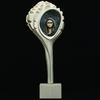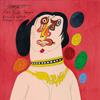CORNCOBS TO COSMONAUTS: Redefining the Holidays during the Soviet Era
- CLINTON, Massachusetts
- /
- November 05, 2018

The Museum of Russian Icons will be presenting Corncobs to Cosmonauts: Redefining the Holidays during the Soviet Era, an exhibition transforming the Museum’s West Gallery into a Russian Winter Wonderland from November 9, 2018-January 27, 2019. The centerpiece of the exhibition will be more than 150 Soviet-era ornaments displayed alongside various-sized and decorated “New Year’s Trees,” together with holiday toys, books, and cards.
The majority of the ornaments have been donated to the museum by collector Frank Sciacca. The ornaments depict a variety of non-religious objects that were important to both the average Russian citizen and the Soviet state. These include folk heroes and cartoon characters, funny clowns and chubby babies, state emblems and objects that celebrate the productivity of farms and factories.
Following the Russian Revolution in 1917, the anti-religion Bolsheviks discouraged Christmas and New Year celebrations in the U.S.S.R. since the gift giving and extravagance that accompanied the holidays symbolized the greed and excess of the aristocracy and bourgeoisie. The tradition of celebrating Novy God (New Year) re-appeared in 1935 as a secular holiday that would symbolize Soviet children’s prosperity and happiness.
The New Year’s tree, or yolka, was repurposed as the main symbol of the celebration but with all religious references removed. The Red Army’s ruby star replaced the tree-topping star of Bethlehem; and the tree was decorated with non-religious ornaments depicting animals, plants, Kremlin architecture, airplanes, and the communist hammer and sickle. After the Soviets launched Sputnik 1 in 1957, figures of cosmonauts, rockets, satellites, and planets became popular. Ornaments that celebrated the country’s achievements in agriculture–like peppers, grapes, and carrots–were sold during Soviet leader Nikita Khrushchev’s time; the most popular being corncobs because of Khrushchev’s infamous “corn campaign” that was introduced as a solution to livestock shortages. The custom of decorating Christmas trees had initially been introduced to Russia by Peter the Great after he visited Europe during the 1700's.

The Russian fairytale figure, Ded Moroz (Grandfather Frost) was said to travel in a horse-drawn sleigh accompanied by his beautiful granddaughter, Snegurochka (The Snow Maiden), to deliver gifts to children to place under the New Year’s tree. He carries a staff, wears valenki, or felt boots, and is carried across Russia in a troika, or a vehicle led by three horses, instead of a sleigh pulled by reindeer.
In the early years of the Soviet regime, Ded Moroz was portrayed as an unacceptable link to old Russia. In later years he became the symbol of Novy God, a move taken by the government as a way to stop the advance of the western tradition of Santa Claus. Ornaments and statues of Ded Moroz, sometimes with Snergurochka, became popular decorations for New Year’s trees and family rooms during winter festivities.
Russians, who account for 39 percent of the world’s Orthodox Christians, were allowed to celebrate Christmas once again after the collapse of the Soviet Union in 1991. But old habits die hard and the Christmas festivities, held on January 7 in accordance with the old Julian calendar, are still overshadowed by big New Year celebrations, which are more like the Western Christmas.
ALSO ON VIEW THIS HOLIDAY SEASON
MATRYOSHKA IN WINTER
October 12, 2018 through February 17, 2019
The mini- exhibition, Matryoshka in Winter, features a selection of nesting dolls from the Museum’s collection that celebrates Russian winter and the Christmas season. Some dolls tell the story of Grandfather Frost and the Snow Maiden, who are said to bring joy and presents to children on New Year’s Eve, while other toys depict Santa Claus, Nutcrackers, and the joyful activities of Russian winter.
The bright colors, distinctive shapes, and creative concepts of Russian nesting dolls have delighted children and adults alike for over a century. The toys are recognized around the world as the quintessential Russian souvenir. Contemporary independent matryoshka artists developed unique and creative styles, taking their work beyond traditional patterns and themes. Transcending the boundaries of conventional Matryoshka production, they elevated the medium from a craft to fine art.
Nesting dolls make an entertaining medium for storytelling and artists sometimes pain detailed pictures on each doll so that the story progresses as the matryoshka is opened. Depicting elaborate stories from the daily lives of Russians to famous fairy tales.
RELATED PROGRAMMING
Corncobs to Cosmonauts Opening Reception
Thursday, November 8, 6:00-8:00pm
Members free, Nonmembers $5.00
Bring the family and celebrate the opening of this fun exhibition with tours by collector Frank Sciacca, holiday desserts and crafts. RSVP by November 5. Call 978.598.5000, x121.
Gallery Talk: From Corncobs to Cosmonauts
Saturdays, November 10 & 24, December 22 at 1:00pm
Free with Admission
Registrar Laura Garrity-Arquitt explores the special exhibition From Corncobs to Cosmonauts: Redefining the Holidays in the Soviet Era.
Pop-up Makerspace: Cosmonaut Edition
Wednesday, December 26-Sunday, December 30, 11:00am-5:00pm
Free with Admission
Drop in to the Museum’s Pop-up Makerspace, inspired by the exhibition From Corncobs to Cosmonauts. Activities include daily design challenges and crafts appropriate for all ages.
In celebration of Corncobs to Cosmonauts, the museum shop will have vintage and modern Russian ornaments, Christmas and holiday décor, and gifts for sale throughout the holiday season.
ABOUT THE MUSEUM
The Museum of Russian Icons inspires the appreciation and study of Russian culture by collecting and exhibiting icons and related objects; igniting the interest of national and international audiences; and offering interactive educational programs. The Museum serves as a leading center for research and scholarship through the Center for Icon Studies and other institutional collaborations. It is the only museum in the US dedicated to Russian icons, and it is the largest collection of icons outside of Russia.
Museum hours: Tuesday–Friday, 11AM to 4PM; Saturday and Sunday, 11AM to 5PM. First Sunday of the month: free admission! Closed Mondays.
Admission: Adults $10, seniors (59+) $7, Students $5, Children (3-7) $5, Children under 3 Free.
For more information, please visit museumofrussianicons.org.
Contact:
Nina BergerMuseum of Russian Icons
6175431595
ninajberger@gmail.com
203 Union Street
Clinton, Massachusetts
info@museumofrussianicons.org
978.598.5000
http://www.museumofrussianicons.org/
About Museum of Russian Icons
The Museum of Russian Icons inspires the appreciation and study of Russian culture by collecting and exhibiting icons and related objects; igniting the interest of national and international audiences; and offering interactive educational programs. The Museum serves as a leading center for research and scholarship through the Center for Icon Studies and other institutional collaborations. It is the only museum in the US dedicated to Russian icons, and it is the largest collection of icons outside of Russia. Museum hours: Tue. - Fri., 11AM to 4PM, first Thurs of the month to 8PM, Saturday and Sunday 11AM to 5PM, closed Mondays. Admission: Adults $10, seniors (59+) $7, Students $5, Children (3-7) $5, Children under 3 Free. For more information please visit museumofrussianicons.org.















